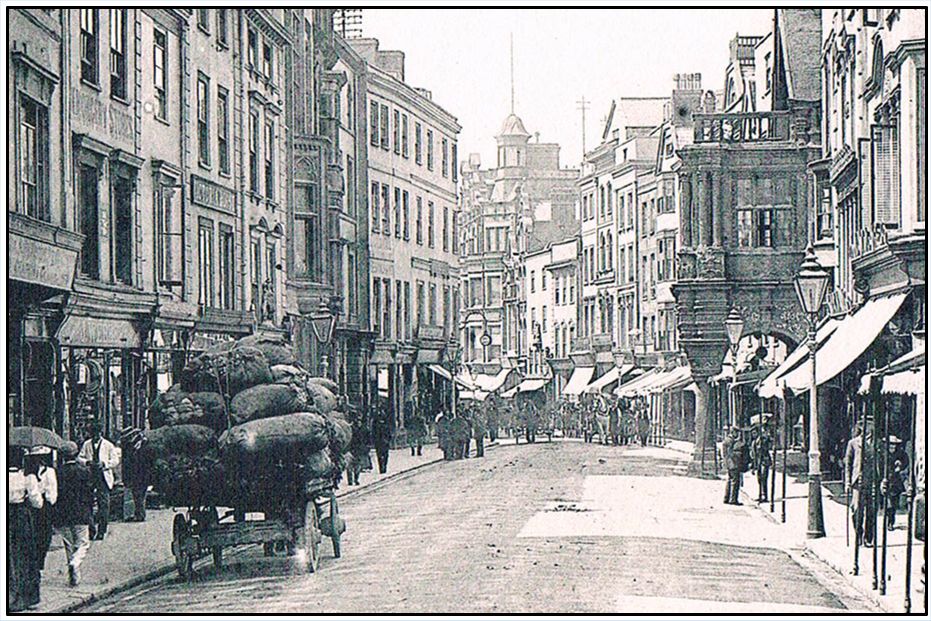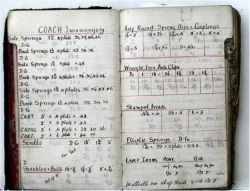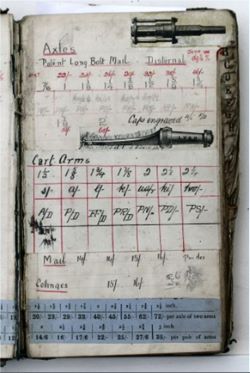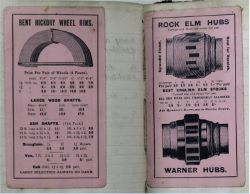


This view, westwards down the High Street, was taken in the era when the horse reigned supreme, not even a cyclist in sight and curiously only two women. However, the streets in our towns and cities were becoming severely polluted by manure, and the flies it attracted spread disease, including typhoid. The average life of a working horse was about 3 years; it produced a couple of pints of urine and around 25lbs or more of manure a day, some of which can be seen in the image! Garton & King’s premises at 190 High Street, complete with the Royal Coat of Arms can be seen in the distance, the light coloured building two up from Paternoster House (onetime Cornish’s) at the junction with North Street. The only ‘modern’ invention visible are the gas lights, they had been around since 1815.

 It’s all too easy to forget that throughout much of the Victorian era we (in the westcountry) were almost totally dependent on horsepower to get about on land, whether for personal transport or the carriage of goods or providing the network of Stage & Mail Coaches. Transportation was still mainly down to the horse. Steam powered vehicle design developed greatly in the first part of the 19th century but this progress was severely dampened by legislation, ie: The ‘Red Flag Act’ 1865 and limitations on speed.
It’s all too easy to forget that throughout much of the Victorian era we (in the westcountry) were almost totally dependent on horsepower to get about on land, whether for personal transport or the carriage of goods or providing the network of Stage & Mail Coaches. Transportation was still mainly down to the horse. Steam powered vehicle design developed greatly in the first part of the 19th century but this progress was severely dampened by legislation, ie: The ‘Red Flag Act’ 1865 and limitations on speed.
The Bristol & Exeter Railway eventually reached as far as Exeter in 1844, to Plymouth in 1849, the line to Crediton in 1851 and to Barnstaple in 1857. The London & South Western Railway reached Exeter (Queen Street) in 1860. Exeter did not have its small layout of horse-drawn tramway until 1882 and the electric tramway system was, in the latter half of the 19th century, but a far-off dream (1905). So, on the highways and byways the horse was still supreme and bolstering up the ‘Horse Economy’ that businesses such as Garton & King, and their predecessors Garton & Jarvis, prospered from.
Much of the company’s sales (through the Ironmongers shop as well as the foundry) were horse connected, whether it was harness and stable fixtures and fittings or related to work on or repair of the variety of carriages and carts that provide a means of getting about or a means whereby goods could be distributed.
Wheelwrights, smithies, harness makers and carriage makers were in abundance and the skills to produce much of the metalwork, bolts, springs, metal stable fixtures and fittings were retailed from and often produced at the company’s premises.
Unfamiliar names to many of us nowadays were, progressing up the list from the lightweight to the heavyweight, Phaetons, Gigs, Brakes & Hansom Cabs. Carriers’ wagons, Devon ‘Ship’ wagons, Timber Carriages etc.
One large westcountry manufacturer was the Bristol Wagon Works who, in 1889, became the Bristol Wagon & Carriage Works Co. In 1913 they became involved in building railway trucks & carriages. The company actually made Exeter’s first single deck tramcars for the Horse Tramway; numbers 1, 2 & 3.
 Examination of the image from the 1899 Price Book gives some indication of the dimensions and descriptions and terminology of that time under the heading ‘Coach Ironmongery.’
Examination of the image from the 1899 Price Book gives some indication of the dimensions and descriptions and terminology of that time under the heading ‘Coach Ironmongery.’
Elsewhere on this site are mentions and images of stable design, fixtures and fittings, particularly the pages on ‘Saltram House’ and the ‘Mixed Bag’ page.
All of the medium to large houses had a stable complex, such mansions as Killerton, Saltram, Knightshayes, Tregothnan, Shobrooke, Powderham, Port Eliot, Holcombe, Arlington etc. The list is considerable and as most patronised the Company they can be seen listed on our ‘Customers’ page.
The majority of the larger locations still have their Stable buildings, and in many cases the fixtures and fittings are still in situ. Often it is only the horses that are absent!
 The next two images are from a Pricing Book from about 1900. The first image gives details of Cart Arms and Axles. I believe the prices are shown as a Code – e.g. FF/- and PR/D. The book gives details and costs on a wide variety of products, from Grindstones made of Yorkshire Grit to Horse Clippers, Gutter Brackets, Hollow Ware, Cart Grease, Bees Wax (imitation or real), Raffia Grass and Rabbit Traps. It’s useful to know that if the Rabbit Trap spring breaks replacements are available separately!
The next two images are from a Pricing Book from about 1900. The first image gives details of Cart Arms and Axles. I believe the prices are shown as a Code – e.g. FF/- and PR/D. The book gives details and costs on a wide variety of products, from Grindstones made of Yorkshire Grit to Horse Clippers, Gutter Brackets, Hollow Ware, Cart Grease, Bees Wax (imitation or real), Raffia Grass and Rabbit Traps. It’s useful to know that if the Rabbit Trap spring breaks replacements are available separately!
 The pink tinted adverts are of interest as they stipulate the wood used; Ash for shafts, Hickory for the wheel rims and Elm for the Hubs. The prices shown are from around 1900. The hubs, needless to say, are well seasoned and elm is the preferred wood as the grain makes it resistant to splitting. Unfortunately the supplier’s name is not given
The pink tinted adverts are of interest as they stipulate the wood used; Ash for shafts, Hickory for the wheel rims and Elm for the Hubs. The prices shown are from around 1900. The hubs, needless to say, are well seasoned and elm is the preferred wood as the grain makes it resistant to splitting. Unfortunately the supplier’s name is not given
One of the Stable Fixture Catalogues in our archive can be conveniently dated, as there is a note pasted on the first page dated 1st May 1872. The pages can be seen on this page, so click on the image and ‘COME ON IN’, but make sure the stable door is closed - we wouldn’t want the horses bolting!
May 2021
Top of page
See also:
High Street — Oddities, Stories & Trivia
144 Years of Newspaper Ads — King & Munk
Mixed Bag — Saltram House
Sitemap / Contents